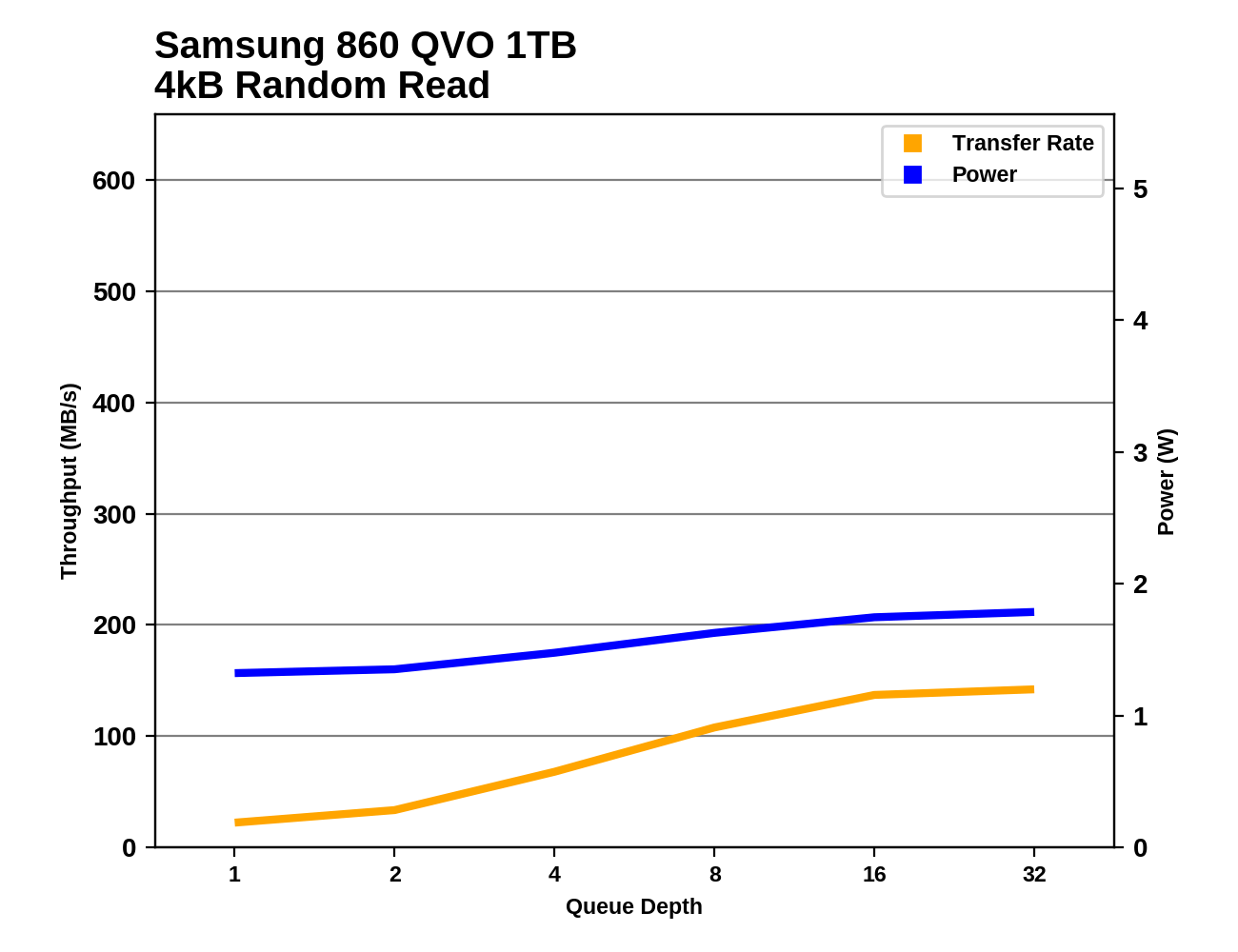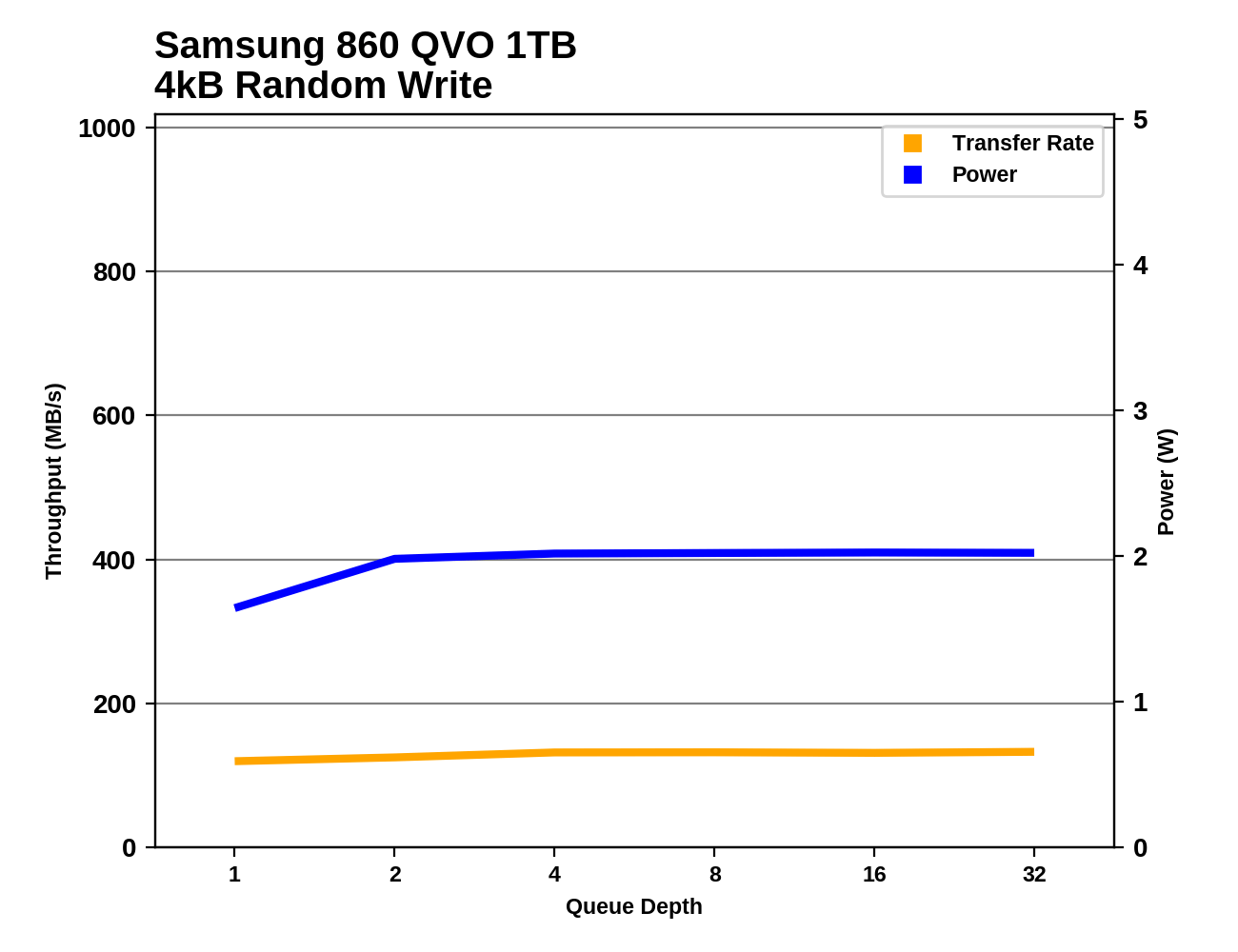The Samsung 860 QVO (1TB, 4TB) SSD Review: First Consumer SATA QLC
by Billy Tallis on November 27, 2018 11:20 AM ESTRandom Read Performance
Our first test of random read performance uses very short bursts of operations issued one at a time with no queuing. The drives are given enough idle time between bursts to yield an overall duty cycle of 20%, so thermal throttling is impossible. Each burst consists of a total of 32MB of 4kB random reads, from a 16GB span of the disk. The total data read is 1GB.

The burst random read performance of the Samsung 860 QVO is clearly lower than the 3D TLC competition, while the Intel/Micron QLC NVMe drives have no trouble competing against the field of mainstream SATA TLC drives. Even in the worst case of the smallest QVO being entirely full, read speeds are still vastly better than a hard drive.
Our sustained random read performance is similar to the random read test from our 2015 test suite: queue depths from 1 to 32 are tested, and the average performance and power efficiency across QD1, QD2 and QD4 are reported as the primary scores. Each queue depth is tested for one minute or 32GB of data transferred, whichever is shorter. After each queue depth is tested, the drive is given up to one minute to cool off so that the higher queue depths are unlikely to be affected by accumulated heat build-up. The individual read operations are again 4kB, and cover a 64GB span of the drive.

On the longer random read test, the Toshiba TR200 DRAMless TLC drive is no longer able to stay ahead of the 860 QVO, and even the Intel/Micron QLC drives fall behind most mainstream SATA drives (especially when full).
 |
|||||||||
| Power Efficiency in MB/s/W | Average Power in W | ||||||||
The power consumption of the 860 QVO during the random read test is only slightly higher than its TLC-based relatives, but that's plenty to push its efficiency scores into last place, given the poor performance.
 |
|||||||||
The queue depth scaling of the 860 QVO during random reads is fairly typical in shape, with improvements starting to taper off after QD16. However, the vertical scale is important: the QVO doesn't ever reach even half the performance of the best TLC-based SATA SSDs.
Looking at the 1TB 860 QVO's random read results compared to all the other SATA drives in the benchmark database, it is clear that the QVO isn't anywhere near the cutting edge for power efficiency or peak performance, but there are worse drives out there.
Random Write Performance
Our test of random write burst performance is structured similarly to the random read burst test, but each burst is only 4MB and the total test length is 128MB. The 4kB random write operations are distributed over a 16GB span of the drive, and the operations are issued one at a time with no queuing.

The SLC cache of the 860 QVO is very effective for the burst random write test, leaving it tied or slightly ahead of the 860 EVO.
As with the sustained random read test, our sustained 4kB random write test runs for up to one minute or 32GB per queue depth, covering a 64GB span of the drive and giving the drive up to 1 minute of idle time between queue depths to allow for write caches to be flushed and for the drive to cool down.

On the longer random write test, the larger SLC cache and greater parallelism of the 4TB 860 QVO helps it keep pace with other top SATA SSDs, but the 1TB QVO has to settle for being slightly faster than the DRAMless TLC drive.
 |
|||||||||
| Power Efficiency in MB/s/W | Average Power in W | ||||||||
The QVO is again a bit more power hungry than most of the TLC drives, which doesn't hurt the 4TB QVO's efficiency score much thanks to its good performance, but the 1TB QVO ends up tied for last place with the full-drive performance from the Intel/Micron QLC drives.
 |
|||||||||
The 1TB 860 QVO shows very little random write performance scaling with increasing queue depth, though power consumption does go up significantly from QD1 to QD2. The 4TB 860 QVO shows a much more typical scaling up to saturation at QD4, with a performance curve that is almost an exact match for the 4TB 860 EVO.
There are some TLC SATA SSDs that draw the same power to deliver half the random write performance of the 1TB 860 QVO, but in the grand scheme of things the 1TB QVO's results on this test are sub-par. The 4TB starts out in the same spot but ends up hitting the SATA performance wall without consuming too much power.












109 Comments
View All Comments
R0H1T - Wednesday, November 28, 2018 - link
>moozoohQVO is the first SATA QLC drive, so yeah first of it's kind unless we're being pedantic. As for the price ~ it should & will likely come down soon enough.
>Right now there is exactly zero reason to choose it over the EVO.
The 500GB EVO costs about $130 US where I'm from, there's very little incentive for me to buy it given the "inflated" price.
moozooh - Wednesday, November 28, 2018 - link
> "QVO is the first SATA QLC drive, so yeah first of it's kind unless we're being pedantic."The fact that it's the first or the only doesn't matter to anyone who's buying things based on anything resembling a performance/price ratio. It's the first to be inferior to an already existing product. Who would be the early adopter of something that's clearly worse than something else that costs more or less the same?
> the price ~ it should & will likely come down soon enough
So why didn't Samsung recommend a lower price to begin with, considering how badly this products needs it? I'm sure they follow the market close enough to see this series competes with their own EVO (and loses hands-down).
> The 500GB EVO costs about $130 US where I'm from, there's very little incentive for me to buy it given the "inflated" price.
Yet this makes the QVO more attractive for you, especially considering it doesn't even feature a 500 GB model? I don't understand your argument. The point is this drive needs to be much, much cheaper than the EVO to be attractive at all. The downsides of the QLC NAND are numerous and significant; they need to be offset using the price. It's also clear this is where the multi-bit madness should end, because QLC is already encroaching onto the HDD territory in certain aspects (except the price, sadly) and scenarios. If PLC were a thing, I'd most likely stay away from it even if it were cheaper than hard drives. That's just asking for trouble, like those glass platters in IBM's Deskstar 75GXP (one of the most disastrous HDD series of all time).
R0H1T - Wednesday, November 28, 2018 - link
>The fact that it's the first or the only doesn't matter to anyone who's buying things based on anything resembling a performance/price ratio.The fact is you quoted me when I said first of a kind, which holds true for this drive, end of!
>So why didn't Samsung recommend a lower price to begin with, considering how badly this products needs it?
I dunno, how about you ask Samsung why didn't they sell the 860 EVO for $130 at launch?
>Yet this makes the QVO more attractive for you, especially considering it doesn't even feature a 500 GB model?
Yes because the QVO model, when it launches here, should be cheaper ($/GB) than the EVO drives. It's not like I can't afford $130 drive, but the 1TB or 2TB would be better VFM for me, considering I'm looking to replace some HDDs permanently. The EVOs would probably still be 40~60% more expensive.
moozooh - Wednesday, November 28, 2018 - link
> The fact is you quoted me when I said first of a kind, which holds true for this drive, end of!Once again, the fact that I'm pointing out is that it is a non-argument. Early adopter premium only exists for something that such an early adopter would want to have NO MATTER THE COST. Such as a new feature or better performance with existing features. Here, the cost is the ONLY thing an early adopter would want about it and the only potential advantage, period. Why do you not see how you're not making sense? "One of a kind" is an idiotic argument to use for the product that's intended to be cheaper, not better.
> I dunno, how about you ask Samsung why didn't they sell the 860 EVO for $130 at launch?
They launched the 860 EVO at the same time with the 860 Pro with a significant enough difference in MSRP that one didn't cannibalize the other, and the EVO was also fast enough to overtake most of the competition widely available at that price point. So the pricing made sense at the time, not so much here.
> The EVOs would probably still be 40~60% more expensive.
Hopefully so, but Samsung's lack of aggression and insight in undercutting their own existing product is disappointing. They are well aware of the going price of the EVO.
R0H1T - Wednesday, November 28, 2018 - link
>moozoohWe're forgetting arguably the most important thing ~ yields. There were some (unconfirmed) reports that QLC yields were below par, so it's quite possible that these products being priced so close to TLC drives is a result of that.
moozooh - Wednesday, November 28, 2018 - link
I don't really think yields are important. It's not an attribute for customer to base their decisions on, it's not something that can be tested or seen, and needn't be either—it's the manufacturer's problem. After all, customers aren't altruists and aren't out there to help Samsung or any other vendor do their business—what they need to care about is that the products they buy are priced fairly. Samsung won't convince anyone to overpay for QLC because the yields are too low to justify a fair price.Two possible ways to handle this launch better would be either to bite the bullet and suggest a sensible MSRP from the get go or stabilize the technology before coming out with the product and selling it at a healthy margin. Either way there won't be many people buying this until it's sufficiently cheap so the difference isn't as big as it might feel.
FullmetalTitan - Thursday, November 29, 2018 - link
'Yields don't matter to initial consumer product pricing' is a pretty spicy take.It doesn't matter whether the consumers want to be altruistic (definitely not the correct usage here), this is the price if you want high density SSD storage in a single unit, like it or not. You clearly don't, so kindly shut up and move on.
Manch - Wednesday, November 28, 2018 - link
If the 500GB EVO is double the going price in your area, what makes you think the 860 QVO won't be?Me thinks, you've dug a hole. Stop digging LOL
R0H1T - Wednesday, November 28, 2018 - link
>double the going priceDouble the what? Do you know the price 860 EVO debuted in every country of the world, now can you guess the price QVO would retail for?
How about you stop assuming $130 US (1TB) is the normal EVO price everywhere around the world? Then stop reaching.
s.yu - Saturday, December 1, 2018 - link
If you're knowingly buying from an expensive source, you're buying it wrong. If you insist on buying it wrong, then stop wasting other people's time with your BS.Time to hit eBay, nowadays Taobao may help.